International Art Project
[Between ECO & EGO 2004]
Document Book
Planed and Organized by
Maruyama Yoshiko, Maruyama Tokio, Kaneko Ryoji
Document Book was completed, now on sale!
|
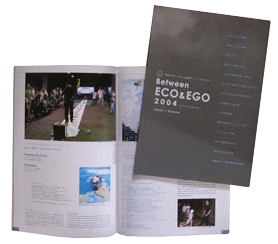 |
Between ECO and EGO - Art and the Rebirth of the City
KOIZUMI Shinya
Art Critic Professor, Ibaraki University
The title of the exhibition, "Between ECO and EGO" was exquisitely connected to the atmosphere of Kawaguchi City, the exhibition's site. After experiencing structural changes in the economy, the city's factories closed and high-rise condominiums were built on the vacant lots they left behind. The high-rise condominiums which replaced the factory chimneys discharging smoke and gas seem to represent the jostling and thrusting of the human ego. The exhibition's new art works spreading across the city, like the new condominiums, also were products of the human ego. However, there were hints of unity between the changing urban setting and the art works. As I experienced the performances and saw the installations throughout this city which I visited for the first time for this exhibition, I sensed that there was a key ideally suited to unite the concepts of the "city of foundries" and contemporary art. When I attended <Talks with Kawaguchi Elders>, the event planned by Yamaoka Sakiko, this sensation became a conviction. When the history of the metal foundries and the city's regeneration following the structural changes in its economy subtly blended in the talk, I made it out that the time and space shared by the artists and the citizens were what united the exhibition. Time and space does not mean simply sharing history and place of residence, but also the will, the hope of rebirth as a new entity through mutual exchange. Furthermore, the city's unique history as a maker of metals seemed to lend an important structure to its attempts at rebirth. Before reviewing each work, I will explain the key concept I am drawing on and how I am using it as a key to the exhibition's underlying meaning.
|
|


|
|
|
|
Forge and Alchemist
Almost half a century ago, religion scholar Mircea Eliade advanced an idea which is now generally accepted: "Alchemy became the foundation of science." He discussed this in The Forge and the Crucible: The Origins and Structures of Alchemy, the book now considered his masterpiece. Eliade's point is as follows: Modern science as it is now practiced lacks the concept of the "sacredness" of material, an important concept in alchemy. Modern physicists and other scientists explore the structure and transmutation of materials only, while alchemists sought the transmutation of both the materials and the human soul together under the premise that they are connected. To view the alchemist only in the light of 19th and 20th century experimental science provides only a rough review of alchemy's profane side.
Eliade described the alchemist's work as including the following three components: (1) Collaboration with the workings of nature. (2) Hastening nature's processes. (3) Transmuting the material. Eliade says that humans experienced collaboration with the workings of nature first through cattle breeding and then through agriculture. Agriculture, especially, would have been a revolutionary step for it requires controlling nature's annual cycles to foster the growth of plants gathered in a field. The seasonal festivals brought forth to celebrate nature's rhythms demonstrate that agriculture was "holy" work. Eliade posits that alchemists applied their faith in such workings of nature to minerals. Mother earth nurtures minerals as well as the seeds of plants. The difference is that the nurturing of minerals requires hundreds of thousands of years. Alchemists made it their art to help speed up the process. This process was analogous to human growth. Alchemists removed minerals from mother earth to refine them into metal by fusing them in the forge. This process can be compared with delivering a newborn baby from its mother then subjecting it to an initiation ritual leading to rebirth as a holy being. The transmutation of the material was the manifestation of the religious symbolism surrounding death and rebirth.
Forges do the same work as alchemists. Forges also use fire to work metal and create tools. They assume the work of god, the organization of the world, here on Earth. To be fused in the forge (which can be interpreted as a matrix) is an essential part of the process of experiencing a kind of death followed by rebirth as a being on a higher plane. By following this process, the individual experiences a severe ordeal (equal to the working of metal) to build up new individuality.
Eliade's entire idea cannot be elaborated in this short essay. However, it is clear that his points will be the key to interpreting this exhibition. The process of artists producing works of art can be compared to the fusing process of the forge. For artists, to be absorbed in their work means to dissolve the ego to blend it into unconsciousness or nonego. This is followed by the crystallization of the artwork so that the ego is reborn as a higher-order being. For example, painters fuse their egos into their paintings, the material, to submit to a new self-image. In the same way, I felt that Kawaguchi City itself is functioning as a forge or matrix in the process of its rebirth through transforming its metal foundries into high-rise condominiums.
Through their work, the exhibition's fourteen artists showed similarity with Eliade's alchemists in that they had various approaches but they all respected and collaborated with nature. They were dissolving their bodies and spirits within the city to be reborn as artwork responding to the industrial city's process of transmutation. A part of one metal foundry has been used as an artists' studio, transforming itself into the Kawaguchi Art Factory. This essay will review each artist and his or her work, starting with the artists using this studio as their exhibition site.
|
|
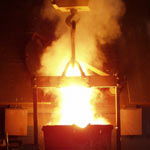 |
|
|
|
Water and Metal
Ikeda Ichi started his art career after majoring in high polymer chemistry in engineering school. He may be said to be an artist/alchemist who turned his back on the transmutative power of fire fearing that modern science was eradicating the holiness of nature. Instead of fire, he has chosen water as his medium. Water has always played a symbolic role, imparting a feeling of holiness in the transmutation of human souls through rituals such as Kanjyo (the Buddhist initiation) and Christian Baptism as "aqua permanens", the origin and destination of all nature. Also, water has a dual character like fire, the power to be both savior and destroyer. In <80,000 Liter Water Box>, Ikeda reversed the story of Noah's ark which tried to save the species from water as destroyer to show the ironic 21st century situation in which water itself now needs to be saved. He contained water in the box to transmute it to his work in a portion of the Kawaguchi Art Factory site. This activity to reconsecrate the role of water ran there for three months. An average person needs 80 liters of water a day to survive. The amount of water needed for 1000 people to live for one day was contained in the box. Forty-eight taps were attached to the sides of the box for the 48 countries predicted to face severe water shortages 20 years from now. Ikeda was appealing to us to be careful so we won't have to open the taps.
|
|
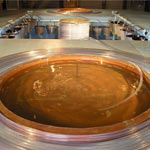 |
In <My Memory/The Memory of Water>, Higuma Haruo made a round seed bed for cultivating radish sprouts. On the surrounding walls, he displayed water collected in different places in four countries. It was contained in bottles and exhibited with pictures of the collectors to indicate the meaning of the word "Memory" used in the title. Water comes down to earth as rain. Then it flows downriver to plants and animals and then to the sea. At last it to returns to the sky. Water changes itself to gas, solids and liquids to be make itself available to all of nature. Higuma showed a bit of the memory of water's incredible journey. At the same time, he was thinking of the relation between the individual and community. He has sent me the growth record of the radish sprouts as mail art several times. In the record, the brown seeds shot forth green sprouts and then changed into a carpet of white, threadlike stalks. The installation showed water rising to the sky along a ray of light in the darkened warehouse.
|
|
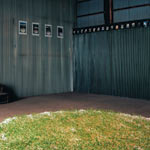 |
<Planetary Magnetic Field Adjustment Project Document> by Itami Hiroshi was a record of grand approaches to adjusting Earth's magnetic field using an apparatus consisting of a monopole magnet of an aluminum metal alloy. Trying to reconstitute the world from its nodal point can be taken as recreation of the world. If we start from the viewpoint that Earth is one living organism, a remedy using magnets is not a preposterous concept. Once, alchemists believed that minerals matured in the womb of the earth and said that the earth is active in the same way as the sea. Today, it is known that plutonium transmutes to plumbum over the millennia and magma convects in the earth. By viewing the earth as one living organism, the whole environment can recover the interconnected relationship with humans and its "holiness."
|
|
 |
In <Distant Voices>, the work of Maruyama Yoshiko, plaster hands cast from the people of Kawaguchi were spread across the floor as if growing from it. Hands symbolize the human as "homo faber". These hands were surrounded by blue boards with images of people also appearing in blue. In the room where the work was set and which once housed a smelter, the bustle of the city could be heard through the audio system which was amplifying signs of the human presence. There we come to understand that materials are only traces of their makers and, hence, similar to ruins. Looking out the window from the room, you could see people walking on the street. In the mirrors set in the room as a part of the work, you could see images of your (virtual) self. By making us look at our actual beings and the beings in our hearts, the work functioned like a device to flip our perspective, making us question us which one was real. After this reciprocity of thought between the two, the substantial being and memory-being become mixed so that an angelic being may be born between the two as a new human form.
|
|
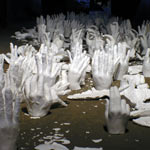 |
<From Destruction to Reproduction>, the work of Kawakami Kaori and <Reserving Memory>, by Kouno Hiroko, were produced in the open studio. These two works demonstrate that material transmutes together with the artist's soul. Both artists worked to expose the essence of their materials instead of controlling the materials with their egos. Kawakami used steel rods which were once part of a brewery used to be a part of a beer factory while Kouno used wood salvaged from a house. Their materials run true to the process of the alchemist's work which tried to generate rebirth at a higher level by experiencing death on the cross. However, the studio was used daily by two artists. As a result, the artists worked in their everyday mind set while visitors to the exhibition came and went. This may have lowered the level of their spiritual suffering and symbolic death, meaning that their rebirth will be less glorious. They could be expected to acquire the holiness of metal and trees in the next level.
|
|


|
|
|
|
Moment and Eternity
Perhaps the most interesting aspect of the installation at the house on Old Nikko Onari Street was the way in which it related to the appearance of the street's traditional architecture. In this work by Kosemura Mami, <Flowering Plants of the Four Seasons -Spring->, images of flowers and plants such as the tree peony in a Japanese-style garden were projected on the sliding screen of a Japanese-style room. The image was an animated film made up of still pictures taken in a miniature garden set up in the warehouse at the Kawaguchi Art Factory. The plants were grown by the artist herself and the pictures were taken over time. Speeding up nature is among the alchemist's arts. In the robot-like awkward motion of the animation, we can feel the presence of the artist animating the images of the flower. The smooth murmur of the wind in the leaves of trees in the real garden, which could be viewed from the window, contrasted with the film to emphasize the art of the animation. The small room was transformed into a kind of paradise where we could experience the eternal repetition of the appearance of flower stems, swelling of buds, and the blooming and withering of flowers. It was an experience that only film could realize.
|
|
 |
< Where To?>, the work of Hirota Miho, was set up in a peacock coop standing in the yard of an old family house. The work suggests one meaning in combination with <Where Have the Foxes of Kawaguchi Gone?>, the work she displayed at the Akuta Museum, the now-defunct recycling center. Hirota was interested in the shrines commemorating Inari that many Kawaguchi residents had in their homes. She visited many houses with these shrines to ask about their origins. Inari is a patron god of the metal industry, and people offered prayers to this fox-god for protection from fire. But Hirota discovered that Inari was originally the god of agriculture, to whom people prayed to ensure a bountiful grain harvest. This flexible god has transformed itself again to the god of commerce and fishery to answer new prayers for survival. Hirota's task was to bring Inari to the next stage. The sculpture in the peacock coop, along with a "memory map" of the locations of old shrines, and telephone voice mail featuring the sound of a barking fox were the components of her work. These elements were connected by visitors who participated by seeking clues hidden in shoe boxes or sticking pins on the map showing shrine locations. Hirota intended her work to function as an mediator for the people who viewed it, an attitude common to all the artists participating in this exhibition, not just an object to look at. Through this project, community tradition once again enlivened contemporary life as a shared experience.
|
|
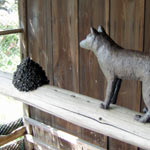 |
|
|
|
eco and ego
One of the exhibition sites was in Ju Mall on Kawaguchi Ginza Shopping Street, the center of a busy area of the community. This public gallery was transformed to a virtual convenience store <TWINS> by Harnaka Koso. On the shelves were PET bottles filled with soil collected in various locations. Soil is the womb of both plants and minerals. In ancient times, human beings also attempted to place themselves in the natural order by tracing their origins to soil. Today, the PET bottle is the world's most popular container: it is cheap to make, fill, and distribute. In the combination of these elements [ soil containing the memory of the ages and PET bottles which are ubiquitous materials in the present day [ we may perceive art in the same way the alchemists did: it consists in creating new values from the fusion of opposites. This approach is also reflected in the choice of a convenience store to serve as a gallery. The fake convenience store was named <TWINS> because Haranaka's twin brother worked there as a "clerk" during the time the space was serving as a gallery. Eco and ego can also be assumed to be twins, interchangeable depending on one's vantage point. In addition, the soils in the PET bottles are displayed alongside newspapers published in the areas where the soil was collected. From these elements, we can see that <TWINS> is designed to mix multiple values.
|
|
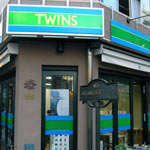 |
<divide 3.0>, the work of Kaneko Akihiko, was set up in a warehouse once used as a municipal recycling facility. In this warehouse, 12 automated, motion-sensitive cameras recorded images which were shown on the same number of monitors set up in another room. The cameras were hung 30 cm from the floor and were initially focused on the floor. When a human visitor was detected, the cameras' motors moved intermittently to record their surroundings. The bare cords connecting the cameras and monitors looked like arteries, giving the sense of being inside the body of an animal: at the same time, they resembled vines. This system is reminiscent of mitochondria, the primal animal cell that coexists with plants, which automatically responds to the surrounding environment. "Divide," the word used in the title, has double meaning, for it indicates diffusion both through cell division and the fragmentation of the environment into the eco and ego realms.
|
|
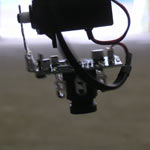 |
Ishikawa Raita deployed three works to illustrate the points of contact between individuals and the consumer/information society. The works blended symbols, words, materials, egos and society in various ways. <Flashpoints> depicted 20th century wars and other conflicts through T-shirt designs. It commented on how these events become commercialized, objects of human desire, through transformation into information and symbols. The stories behind the designs were catalogued, then shown on a PC to highlight the globalization both of regional conflicts and of capitalism. For <True Romance>, transparent acrylic boards covered with messages were set in the precincts of a shrine. One message stated "if you, the only you, disappear, you will be all in all, you will the same as I" They posed questions about religion, love, possessions, and ego. But they urged viewers to question not only the meaning of the messages themselves, but also the identity of the one who asked them. However profound the meaning of these printed words may be, without the creator's existence, the words would seem to be floating in midair. <Fragment Project> was intended as a contrast to <True Romance>. Anyone could write a message freely on one of the red boards and many people contributed their thoughts. Some were written timidly while others were in bold handwriting. This showed the importance of the physical component of individual emotions as an aspect of ego.
|
|
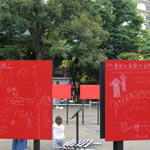 |
|
|
|
Prophecy and Rebirth
I reviewed the videos of performances for which I could not be present at the scene. The opening performance of Maruyama Tokio and Shinjo Kureha seemed to purify the land of Kawaguchi, the site of this exhibition. In the performance <Faraway So Close>, Maruyama extracted the audience's thoughts from their foreheads, combined them with memories contained in the turned soil, and released them into the sky. The point was not the content of each thought but to materialize them and merge them with others and the world. It proclaimed the promise of rebirth through a kind of baptism. Shinjo's performance, <Myth's Future>, started from the symbolic act of mopping the earth. After this, she reached up to the sky standing on a chair set atop a table and then lay on the ground. She seemed to be placing herself in the space between the high-rise condominium and the ground of the former factory site to listen to their stories in the silence as if she were a shaman. She gave a performance at the Kawaguchi Art Factory immediately afterward which was the incarnation of the myth.
|
|
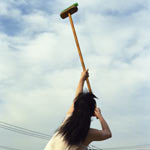 |
Yamaoka Sakiko's <Vault of Time> project consisted of an oral history event, <Talks with Kawaguchi Elders> and two performances. It aimed to build a secure scaffolding anchored in the past across which to walk into the future. I attended the fourth installment of <Talks with Kawaguchi Elders>. The event featured Ms.Terashima Mariko who was a doctor at a clinic in Kawaguchi before her retirements and is now a photographer. She talked about the cruel facts of life in Kawaguchi where pneumonia was once simply accepted as an occupational hazard. She also showed her photographs which graphically depicted the people of Kawaguchi. The event offered an excellent portrait of someone who had transmuted herself through helping guide the transformation of the bodies and spirits of others. Here, we can see the significance of this exhibition's focus on the reorganization of time and space. In the performance, <The Dream of the Turtle>, Yamaoka brought forth numerous balls, bells, and beans from under her skirt, took off her old clothing, put on new clothes, and started walking. The performance suggested that, in order to adopt a new life, you must set your old existence aside and give birth to the new one. The performance, <The Triple Mirror of Memory> was related to <Talks with Kawaguchi Elders>. It was videotaped and intercut with the videos of the three interviews from <Talks with Kawaguchi Elders> to be shown on the street. The meaning of Yamaoaka's work became clear when it was revisited after awhile far from the original scene. In the performance, she faced a triple mirror which symbolized the three interview. She walked backward into the scenery reflected in the mirror (leading three other people holding mirrors, a teenager, and several audience members. - Ed.) toward Zenkouji Temple. However, she could not view the entire scene in the mirror since she was standing in front of the mirror, hiding it. At this point, it seemed that the mirror was functioning as a sort of reverse gear. The dominant world in the foreground disappeared as a result of her own reflection. This strange party then strolled across the busy National Route as if there were no traffic. The performance seemed to suggest that memories are like mirrors that make the reality in front of us disappear. Perhaps <Talks with Kawaguchi Elders> was urging us to reverse our viewpoint and make us see the factual world we live in from the viewpoint of memory, not to bring back the memories themselves. Then, on to Zenkouji Temple, the walk's destination. The temple itself was destroyed by fire forty years ago so only the cornerstones and piles of stone figures remain. We can no longer imagine what it used to be like. Once, many worshippers crossed the Arakawa River to visit this temple by the side of the river. I imagine that this place might once have looked like "Higan" (The world of death. - Ed.) from Edo (Tokyo) just across the Arakawa. The temple turned my thoughts to the Kawaguchi elder who had said that once the fire from its foundries at night made the whole city appear to be ablaze. It made me feel that the city, too, was trying to turn to "Shigan," the world of life, through the power of fire.
|
|
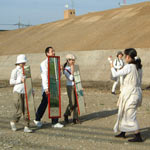 |
The symbol of rebirth was central to <Transition>, the performance by Maruyama Tokio. At the performance site, two chairs were facing across a long distance. One of the chairs was balanced on a globe set under one leg. On the floor, small wooden blocks were scattered like stepping stones. Maruyama, holding a ruler in his mouth, crossed the room stepping on the blocks, sat on the unstable chair and fell back. He arose immediately and walked back to the other chair standing the wood blocks upright along the way. When he got to the opposite chair, he seated a skeleton on it and placed an artificial eye in its eye socket. The skeleton then fell over and Maruyama let the ruler drop from his mouth. Then he tied netting which had been spread on the floor beforehand. Suddenly, he dashed out of the window behind him, climbed over a fence, and ran off into the bushes on the hill. In the room, the fallen skeleton and chair were left. The fall of the ruler symbolizing human rationality obviously represented the fall of the rational world. Righting the wood blocks which were once trodden on represented the transition from the utilization of nature to its recovery. Furthermore, putting the eye in the skeleton obviously represented rebirth. The ending of the performance, when Tokio overturned everything he had done, has two possible interpretations: the destruction of or the rebirth from a destroyed world. We are the ones who must choose.
|
|
 |
|
|
|
Afterword
After reviewing all the works in this exhibition, I continue to reflect on the concept characterized by its logo with the overlapping words "eco" and "ego."
Some people say the protection of nature may be impossible while others argue its importance on many levels. It is true that human existence is based on manipulating nature. It is also true, in a way, that religion, science, art, civilization, and culture emerged only when we separated ourselves from nature. However, was it not the alchemic vision that prevailed for so long, longer than those of religion, science and art in our history? The concept of religion is said to have taken its current form at the time of the Reformation. Science and art are also modern concepts. We begin to notice that our culture is losing its foothold when our civilization, which was thought to have controlled nature through technical means, becomes increasingly directionless. Is it possible to go back to the point where we separated from nature? No, it is not. However, by questioning authority, attending to our surroundings, and experiencing the death and rebirth of ego in a symbolic way, we can approach the matter from an artistic viewpoint instead of retreating into the intolerance of fundamentalism. Art must also be reborn together with the city and its people.
|
|
 |

|